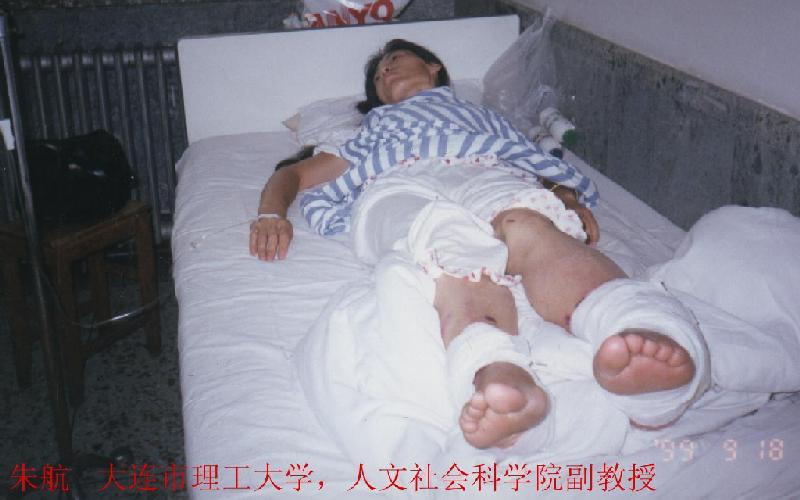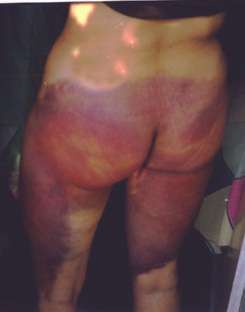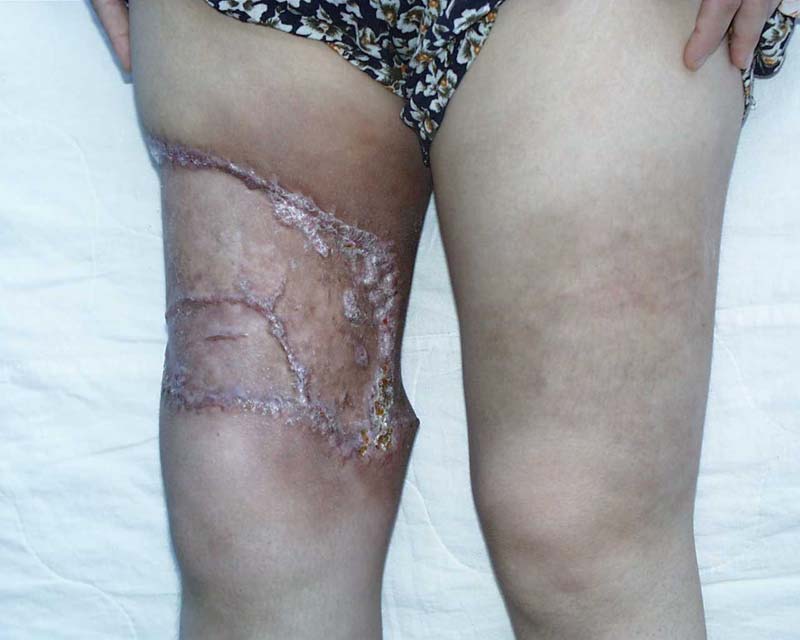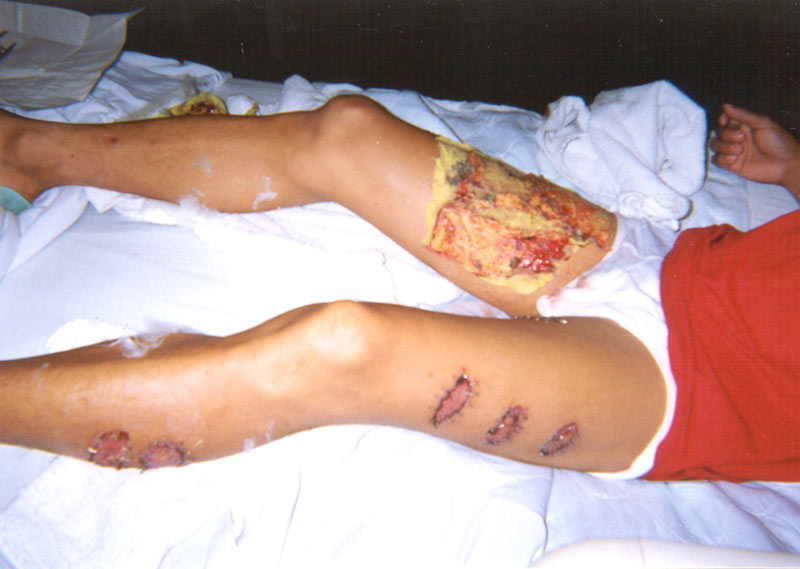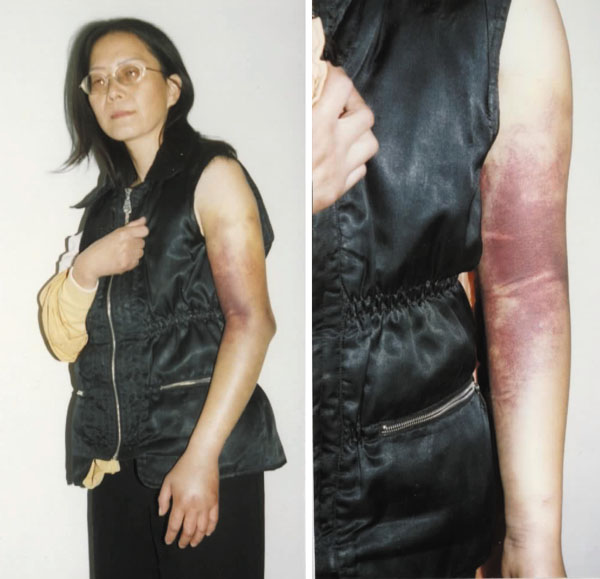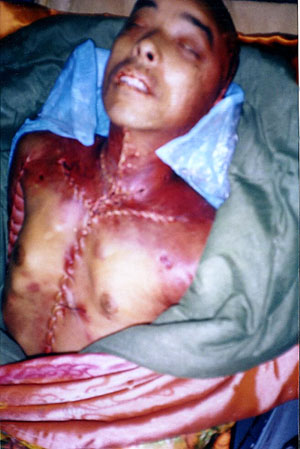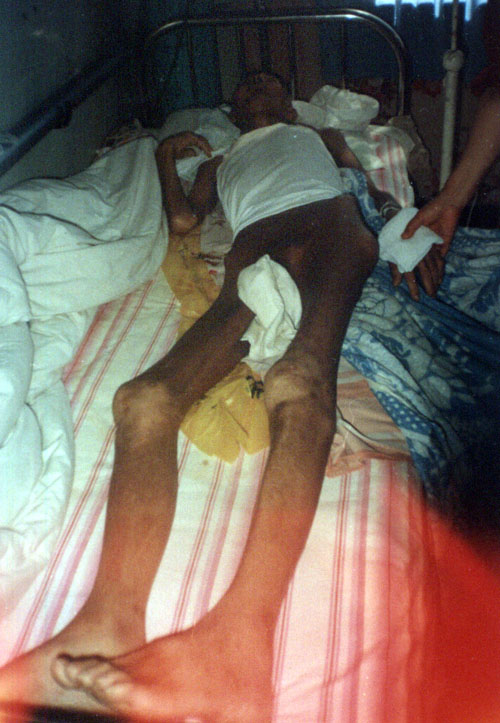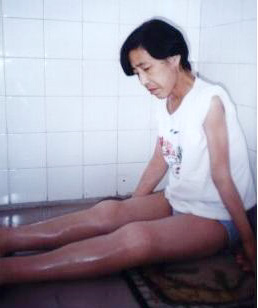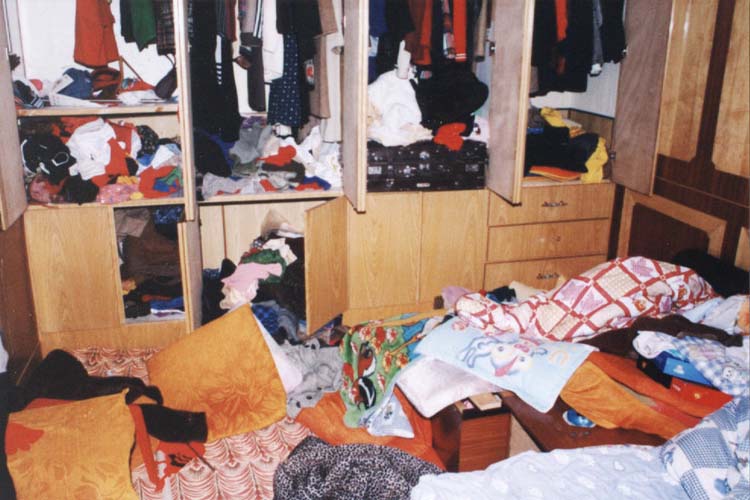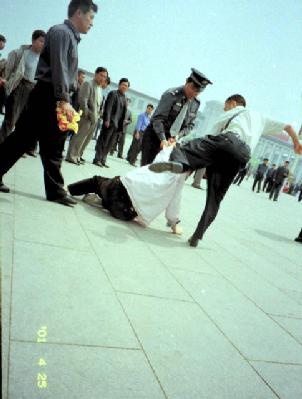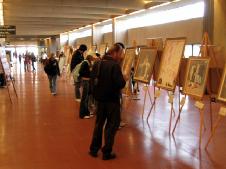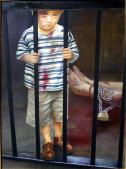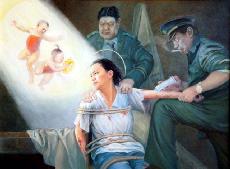
ABOVE: Detail from Marcus Wills’The Paul Juraszek monolith (after Marcus Gheeraerts), winner of the 2006 Archibald Prize for portraiture.
The vaguely creepy picture above is this year’s winner of the Archibald Prize, the Australian award for portraiture. Marcus Wills’ painting of sculptor Paul Juraszek depicts the portrait subject 29 times, as tiny versions of himself working on a larger monument of his own head. The somewhat limp controversy being cooked up over the painting involves the fact that it is a close replication of a 16th century etching by Flemish artist Marcus Gheeraerts, the Allegory of Iconoclasm.
The similarity between the works is undisputed, as Wills’ painting is obviously based on the original etching, and he references the original work in the title. But some people feel that while the new painting is technically accomplished, it’s too derivative to win one of the world’s premiere portraiture prizes. But given the competition, this looks like the clear winner to us.
Jocks, Artistes meet amicably in Australian exhibit

ABOVE: Detail from Richard Lewer’s I was either going to be an artist or own my own sport shop, part of the current Melbourne show “Game On!: Sport and Contemporary Art”, through April 23.
The rigid division of the world into various high-schoolish cliques is a fact we much bemoan: jocks, preppies, geeks, weirdos, etc—many of these sad and limiting labels seem to survive the transition to real life (i.e., everything that is not high school). For those among us who have sat morosely sketching pictures of bleeding eyeballs in the hallway listening to whiny rock music while the lacrosse team rumbles through on the way to their ball-and-stick exertions, it is a truth universally understood that the boundary between “jock” and “art-class-freak” is impermeable to all but the most gifted and despicable individuals. But a new exhibit in Austalia boldly crashes that barrier, and it sounds worth a look.
Game On!: Sport and Contemporary Art opened in January and continues through the end of April, and it is dedicated to art that addresses sport, and the artists who are taking the public and private ritual, the spatial enormity, the mythical celebrity, and the dynamic physicality of the sporting world as their subjects. New Zealand Art Monthly has reprinted in part some of curator Chris McAuliffe’s catalogue essay for the show, and while it gets a bit wonkish in parts, it makes a compelling case that this show could mark the beginning of a beautiful friendship.
Japan, HP collaborating on art reproduction printing job

ABOVE: Detail from Tigers, from a series of panels from Nanzen-ji Temple; the deteriorating paintings will be replaced soon with high-tech reproductions.
HP, the company that is taking us all to the cleaners with every overpriced inkjet cartridge we buy, is partnering with the Kyoto International Culture Foundation in Japan to make high-quality reproductions of irreplaceable and delicate artworks from temples across Japan. The Kyoto Digital Archive Project will make reproductions of 3,500 pieces of art, spanning between the 13th and 17th centuries, and the originals will be moved to special climate-controlled storage so their forgeries stunt doubles can take their place.
HP is reportedly pursuing fine art reproduction as a growth area for their business: CNN Money says the art reproduction racket is a $7.5 billion per year industry and growing fast. Making the high-resolution digital scans of the art, and then using cutting-edge printers to make the repro is persnickety work, the kind of skilled work that you can charge an arm and a leg for. Better keep those ink cartridges, then.
Sotheby’s auction to break Australian art price barrier?

ABOVE: Detail from John Brack’s The Bar (1954), which has already provoked record-breaking estimates on its auction price.
It’s summertime in Australia, and the living is easy. The hot-ish Australian contemporary art market has puffed The Bar, a newly available painting by Australian artist John Brack, into the rarefied, oxygen-starved, braincell-killing stratosphere inhabited by major collectors. The painting is expected by auctioneer Sotheby’s to fetch upward of AU$2 million, a record for any 20th century Australian painting, and not quite 300 percent more than Brack’s previous high seller, which went for AU$530,000 only two years ago. If, that is, The Bar actually reaches that price point. But the painting is considered a better one than Collins St., 5 p.m., a Brack painting which is a prized possession of the National Gallery of Victoria.
The Bar was snapped up by a Melbourne collector when it first showed in 1955 for 90 guineas (who knows what the hell a guinea was worth, but rest assured it was a bargain in the long run), and that collector’s death just last month has placed the painting on the block. So far as we can tell, there’s no date for the sale yet, but it’ll be sometime this spring.
1,000 year-old Vietnamese painting restored in Hanoi

ABOVE: an 11th century Vietnamese painting of a one-pillar pagoda, from the collection of Trinh Quang Vu.
Painters and historians at the Vietnam Industrial Art University have completed a restoration project including paintings from the 11th-century Ly Dynasty, Vietnamese websites reported yesterday. Truong Quoc Lap, Trinh Quang Vu, Pham Tam, and Nguyen Tuan collaborated to buff up 54 paintings from the collection of painter and art professor Trinh Quang Vu, a group of paintings spanning about 900 years and depicting a variety of subjects.
Interestingly, the majority of the paintings are by Chinese and European artists, mostly traders and clergymen. This in fact may account for the somewhat workaday subject matter—the foreigners were interested in depicting customs and events that the locals probably found too prosaic to record themselves. The paintings will go on display at Kinh Thien Temple on January 25.
Philly museum gets special Korean curator

ABOVE: Hyunsoo Woo, who has just been appointed Curator of Korean Art at the Philadelphia Museum of Art, a new position.
The Philadelphia Museum of Art announced yesterday that it had appointed Hyunsoo Woo as associate curator of Korean Art, a newly-created position made possible by wealthy museum donors. The museum, which has in the past worked closely with Philadelphia Korean-American groups, has a sizeable collection of Korean art. Woo comes from past posts at the Japan Society in New York and the Brooklyn Museum.
As cities become more cosmopolitan and ethnically mixed, more and more of them are going to see such moves: museum board members and donors have long since ceased to be old-money WASPs with a taste for potbellied Regency writing desks and little else. Affluent cultural groups want to see their heritage reflected in public institutions too, and they have the chequebooks to make it happen. While the Philadelphia Museum of Art declined to name the donors who made the appointment possible, so we don’t really know the full story, but in this case, and undoubtedly in cases yet to come, it isn’t hard to connect the dots.
ADD Abridged—Sting in San Fran, Bi in Shanghai

ABOVE: Detail from Stephen Foss’s Untitled 18, recently recovered in California after a sting operation.
Today we introduce ADD Abridged, a less wordsome variation on ADD, which will last the rest of the week, for a number of reasons, all too crushingly dull to detail here. Our windedness will elongate again, as per usual, next week.
- Sting in San Fran — Your average thieves-steal-car, car-contains-art, police-establish-complex-sting-operation love story. SF Examiner > Stolen art recovered after sting operations
Bi(ennial) in Shanghai — Shanghai unveils theme of 2006 Shanghai Biennial: “Hyperdesign,” to be dress rehearsal for 2010 World Expo. Xinhua > 6th Shanghai Art Biennial slated for next Sep
Indian income increase — Fledgling Indian contemporary art auction house Saffronart sets record with $12.5 million sale. Rediff > Auction of India art fetches Rs 55 cr in NYC
See you tomorrow with more extra-concise goodness…
Christie’s Is Forever: Auction house slips into China

ABOVE: Detail from Lin Fengmian’s Four Beauties, one of 450 pieces to be sold during Christie’s first ever sale in China, on November 3.
The stampede into China took a great leap forward yesterday—pun intended—when top-shelf auction house Christie’s announced [PDF link!] that it has established a pseudo-subsidiary in Beijing. The new auction house, named, rather grandiosely, “Forever,” has a sort of arm’s-length relationship going on, in order to neatly skirt China’s foreign-ownership laws: Christie’s will put its name on the auction, its curators will appraise the works, it historians will print the catalogue, and its auctioneers will wield the hammer. What exactly Forever does, in its no doubt richly-rewarded role as puppet company, is unclear.
The first Forever-Christie’s auction will be held at the Sheraton Beijing on November 3, featuring about 450 artworks expected to fetch up to $10 million. Naturally, the hype about Asian art being what it is these days, it’s possible it could be much higher. The market for art within Asia is bigger every year, and growing in leaps and bounds; no doubt Christie’s wants a finger in that pie. But art auctions are a two-way street: just as flush Asian buyers have been snapping up art around the world for a while now, this new deal gives Christie’s a shunt directly into a very rich vein of asian art that’s in big demand in the west. Christie’s may have obeyed the letter of Chinese law in their deal with Forever, but we bet the People’s Liberation Army is none too pleased.
People’s Army relic hunters reclaiming Chinese artworks by any means necessary

ABOVE: It’s an inapt analogy, but the People’s Liberation Army of China is spending vast money and manpower on taking back chinese artifacts from Western collectors. Kind of a reverse Tomb Raider thing.
Reason #3968 to be scared shitless of the Chinese army: after centuries of art pillaging—among many other kinds of pillaging—by Western collectors, China is fighting back with some scary secret-agent shenanigans and a big pile of U.S. money. This article from the International Herald Tribune tags along with a Belgian, Giselle Croes, who has been jetting around buying rare pottery and bronzework in shady deals in shady surroundings on behalf of the People’s Liberation Army and its business arm, Poly Group. China is sitting on more than $700 billion in foreign currency and wants to buy its stuff back. As a consequence, the selling price for the type of items it’s interested in have jumped to record levels.
Croes says that Poly’s vaults contain art worth over $100 million, amassed in less than ten years. That buying spree, says the Tribune, has been at least partly funded by $200 million worth of arms sales by Poly Group in the US. The drive to reclaim thousands of pieces of Chinese art, representing pieces from 3,000 BCE to the present day, is being directed with military enthusiasm by the Zong Chan Second Division, a squad of elite officers who are directing the movements of dealers around the world, just like Ms. Croes. They’re ready to make offers you can’t refuse.
LINK: International Herald Tribune > China is racing to get its art treasures back
Australia considers art investment to fund nat’l retirement

ABOVE: detail from Jackson Pollock’s Blue Poles (1952), which National Gallery of Australia chairman Harold Mitchell recently said he was offered $100 million for. Such works could become part of Australia’s long-term investment for government pensions.
Call your brokers! Sell sell sell! Take your money out of those stupid blue-chip stocks and buy yourself a Kandinsky or a Picasso, ASAP. Citing the stratospheric appreciation demonstrated by 19th and 20th century American and European modernist masterpieces, the National Gallery of Australia is pushing for a new plan which would invest hundreds of millions of dollars of the Australian government’s pension fund in such works.
The Australians have set aside AU$16 billion this year for a so-called “Future Fund,” to invest for public-sector pensions (expected to reach AU$140 billion per year by 2020). It will be topped up with more after the government sells its partial stake in its semi-privatized telecom business Telstra Corp. The NGA sees an opportunity to build its collection (it had to pass on a Kandinsky earlier this year for lack of funds) and prove it can earn its keep financially. The proposal calls for 1-2 percent of the Future Fund—in the AU$300 million range—to be sunk into acquisitions for the national gallery, where the works can be displayed for the public’s pleasure now and sold off at a hefty profit later. For cash-strapped public galleries everywhere, this is an experiment to watch very carefully
Druglords trafficking $6 billion in art every year: UNESCO

ABOVE: Details from stolen art objects being sought by the FBI Art Theft Program (from left, one version of Munch’s The Scream, a clay pot which was among the artifacts stolen from an American Indian cultural center in Indio, Calif., and Munch’s Madonna). Trafficking in art is now thought to be a $6 billion a year business.
The world black market in stolen art is worth $6 billion a year, Prof. Amareswar Galla, vice-president of the International Council of Museums, informed a UNESCO workshop this week, and is the second largest such illegal trade after narcotics. It’s no coincidence, either, as Prof. Galla explained, since drug cartels are apparently sinking their profits into art and artifacts or using them as currency in cross-border deals.
“Trafficking in cultural property,” as the UNESCO people call it, is especially problematic in Asia and the subcontinent because, as Dr. Galla said in this story from the Navhind Times, “the 1954 Hague convention on the subject is extremely euro-centric and does not address the concern of asian nations.” Essentially, billions of dollars worth of artifacts, and the priceless cultural heritage that goes with them, are being sucked out of the developing world and used to fund black markets in the West. Welcome to civilization.
LINK: Navhind Times > Trafficking in art objects next only to narcotics trade: UNESCO
Chinese Frankenfetus pulled in Switzerland amid outrage

ABOVE: Detail from Xiao Yu’s Ruan (1999), which is a real human fetus head grafted onto a real seagull body, preserved in formaldehyde. The work is being “investigated” after being removed from a show of contemporary Chinese art in Bern.
OK, we’ve all watched Six Feet Under, and every Sally Housecoat in the Western Hemisphere is a CSI addict: the sight of putrefying human flesh has lately come to be considered light entertainment. So it’s a little surprising that the above image still inspires such visceral shock and disgust. But it is. This is disgusting. It’s the head of a human fetus grafted on to the body of a seagull with rabbit eyes sewn on to its face. The artist, Xiao Yu, says that the seagull and the fetus both died because there was “something wrong with them,” (this is what he told the Associated Press) and that sewing them together allowed them to “have a new life.” So there’s a statement being made here—our question is whether this statement required, um, human taxidermy.
Evidently, that’s the same question that Adrien de Riedmatten, the concerned citizen who complained to the Bern, Switzerland, District Attorney’s office, also asked. It seems that there is confusion about where and when the fetus head originated (what, did Xiao keep the receipt or something?) and how exactly it shuffled off this mortal coil. Riedmatten refers to it as a “baby,” which is obviously a terminological scab which we will not pick at here. Anyway, the show of Chinese avant-garde art, “Mahjong,” is still forging ahead at the Kunstmuseum Bern without Yu’s piece, which was part of the 2001 Venice Biennale. On August 22 the museum is hosting a symposium with philosophers, ethicists, and artists to decide whether to put Ruan back in.
Australian Aboriginal art raking it in

ABOVE: Detail from Emu Corroboree Man (1972) by Australian Aboriginal artist Clifford Possum Tjapaltjarri. The work fetched a record price in Melbourne in late July.
We so often neglect Australia, The Littlest Continent. Aside from churning out hollywood movie stars, it seems to keep to itself most of the time. So it came as news to us that Australian Aboriginal art is doing huge business there, with many artists seeing their auction prices higher than they’ve ever been. Exhibit A (actually, the only exhibit today): A July 25 Sotheby’s sale of Aboriginal art in Melbourne moved a total of AU$4.8 million worth of work. The National Indigenous Times reports that there was something of a bidding war for two pieces by Clifford Possum Tjapaltjarri, Emu Corroboree Man, above, and Man’s Love Story, and the artist hit a new personal best, price-wise. Emu’s initial price ceiling was AU$250,000, but in the end it sold for AU$411,750, which Mr. Tjapaltjarri would presumably be overjoyed at, if only he hadn’t died in 2002. Timing.
The Nat’l Indigenous Time’s story also quotes Jon Dwyer, director of painting for Christie’s Australia, as saying that “Aboriginal artwork is the fastest growing artwork in the world,” noting that Christie’s will be holding its own auction of Aboriginal art on August 30 for which expectations are high. So this Dwyer fellow is, like, totally impartial and has no vested interest in generating hype. You can believe him.
China and Japan get along at Mori Museum

ABOVE: detail from what we think is Cao Fei’s video work Hip Hop (2003) in which passersby on a city street are asked to do spontaneous dance moves. The work is part of the Mori Art Museum’s “Follow Me!” show, on right now in Tokyo.
Like everyone else these days, we’re cuckoo for everything Chinese right now. But what caught our eye about this review of “Follow Me!: Chinese Art at the Threshold of the New Millennium” is that the review is a) from the Japan Times, and b) the show is in Japan. Now, China and Japan aren’t enjoying the most harmonious of diplomatic relations lately, what with all the accusations of war crimes and the smashing of embassy windows in Beijing. Obviously, the show in question, on now at the Mori Art Museum in Tokyo, was planned well before all that revisionist textbook ruckus a few months ago, but it still strikes us as odd. Still, art exhibits in the aid of mutual understanding can only be a positive good, right?
The Japan Times review focuses on what sound like the most crowd-pleasing pieces in the show, which in Japan means crazy pop-culture sincerely-ironic video installations and model skyscrapers that race around like bumper cars by remote control. There are two China shows on at the same time at the Mori, the other being “China: Crossroads of Culture“. Both shows run through September 4.
China warms to contemporary art; Can make it cheaper than the US

ABOVE: detail from Liu Xiaodong’s Prostitute 2 (2001). Liu’s work is gaining in popularity both inside and outside China. Observers have watched the Chinese art market heat up in the last few years, but skepticism abounds.
The Art Newspaper noted yesterday that there are 45 Chinese artists represented at Art Basel this year, a significant jump. Always keen to follow the money, TAN noted that while the market for Chinese art used to be exclusively the decadent west, there is a domestic boom going on, with Nouveau-Riche Reds snapping up contemporary Chinese art at never-before seen rates. The Party has also apparently jumped on the bandwagon and is boosting contemporary artists, apparently even discussing construction of a permanent pavilion at the Venice Biennale, where Chinese officials attened the official opening last weekend.
The Art Newspaper says that this new trend is not driven by money, per se—although prices for art by the hottest Chinese artists are spiralling up into the ludicrous amounts that are now standard everywhere else in the world—but because it’s another area in which they are expanding their diplomatic and cultural legitimacy. Look for a good anecdote in the middle of the story about Jiang Zemin being humiliated on a trip to France when Jacques Chirac tried to talk to him about paintings and Jiang didn’t have anything to say; the official Chinese stance on painting changed soon after he got back from that trip. The French save the world from barbarity once again.
Russian artists: raging against the machine?

ABOVE: detail from Vladimir Dubossarsky and Alexander Vinogradov’s Fanta 1996. Paul Abelsky writes in the San Francisco Chronicle that Russian contemporary art has become just as strange and chaotic as Russia itself.
So, as the Guggenheim in New York prepares to look back over eight centuries of Russian art with its gooey, crowd-pleasing show RUSSIA!, Paul Abelsky, a writer for Russia Profile magazine in Moscow, peers into the murky present in an article yesterday in the San Francisco Chronicle. Russian art, he writes, is in a “predicament,” suffering from “derivative art discourse” borrowed from the west, and strangely disconnected from the realities of contemporary Russian life. The essay is a little strange, wandering off on odd tangents sometimes, but is useful reading for decadent ignorant westerners like us to whom Russia is a vast tundra of onion-dome Tetris backgrounds and cirrhotic 14 year-olds.
Current events in Russia, such as Vladimir Putin’s hardening military stance, interference with the press, and the trial of oil tycoon Mikhail Khodorkovsky, are pushing artists into new territory, Abelsky writes, and they are increasingly targeting the Orthodox church, state imagery, and political leaders. It sounds like it’s producing some profoundly bad art in many cases, but given the strange history of the Russian state and the artists it employs/imprisons, it’s definitely worth paying attention.
Guggenheim! Announces! “Russia!”
ABOVE: detail from Ilya Repin’s Barge Haulers on the Volga (1873), which will come to New York in September as part of the Guggenheim’s eagerly anticipated but obnoxiously named “RUSSIA!” show.
The Guggenheim’s New York franchise yesterday announced its big fall show, which will bring together more than 250 pieces of Russian art, dating back to the 12th century, and some of which have never travelled outside the country before. To adequately capture the excitement this exhibit evokes, the show bears the exciting name “RUSSIA!,” with the caps-lock and exclamation mark mandatory. It will open on September 16 and close in early January.
The show is clearly a massive undertaking, and it’s involved about a dozen curators in Russia and elsewhere; the pieces which will come to the Guggenheim have been cobbled together from museums across Russia, from the State Russian Museum, the Hermitage, the Kremlin Museum, regional galleries, and private collections. The Guggenheim press release says the exhibit will be organized chronologically, starting with medieval icons at the ground floor and spiralling up the corkscrew through genres including romanticism, critical realism (and its evil twin, socialist realism), and ending with post-soviet contemporary works. Seems worth an exclamation mark or two, but it still sounds like the title of a musical adaptation of the complete works of Solzhenitsyn. Coming to Broadway soon: Gulag!
Let’s All Work Hard to Buy North Korean Art!

ABOVE: detail from a hand-painted North Korean propaganda poster, for sale through the Pyongyang Art Studio in Beijing. Flag reads “socialism our way.”
Just a small post today: The New York Times is a bit late to the party on this story about the Pyongyang Art Studio, a Beijing gallery that deals exclusively in posters, canvases, and ceramics from the Democratic People’s Republic of Korea (DPRK). The supersecretive closed communist country puts most of its artists to work on large-scale propaganda posters and murals, painted in the creepy Technicolor pop of the style known as socialist realism. Given N. Korea’s nazione-non-grata status on the world stage, this art was until recently not well-known outside its borders. Then some middle-aged British dude named Nicholas Bonner just swaggers in, cuts a deal with Pyongyang, and sets up an officially-sanctioned DPRK gallery in Beijing to sell North Korean art. According to the gallery’s website, it was written up by Newsweek and the International Herald Tribune way last winter. Why the Times didn’t get to it before now, especially given that they they own the IHT, is a mystery. But as everyone knows, until the Times has covered it, it ain’t been covered, friend.
The art is of mixed quality, but many of the pieces are quite affordable. You too can reduce an entire desperate nation to an ironic dining-room decor statement starting from just US$200.
Rock, Paper, Scissors decides Sotheby-Christie broker war

ABOVE: Big-fish auction houses Christie’s and Sotheby’s determined who would win a $20 million contract last week by playing a long-distance game of rock, paper, scissors. Right: a detail from Cézanne’s Les grands arbres au Jas de Bouffan (circa 1885), expected to fetch upwards of $12 million at Wednesday’s sale.
When Takashi Hashiyama couldn’t decide which international auction house should put his company’s $20-million art collection under the hammer, he did what is apparently quite normal in Japan and asked them to play “Rock, Paper, Scissors” for the commission. Tokyo reps for the companies were given the weekend to decide their weapon: Christie’s cut the ribbon on the lucrative deal with a decisive “scissors” win. Apparently Flora and Alice, the daughters of Christie’s international director of Impressionist and modern art, were the ones who settled on the gambit. The New York Times quotes a Sotheby’s exec saying “this is a game of chance, so we didn’t really give it that much thought. We had no strategy in mind.” Well, we know why they lost.
Of course it’s all a brilliant publicity stunt, a bit of harmless fun that incidentally gets the sale serious column inches in the Times and other chunks of pricey media real estate [and the not-so-pricey ADD - ed.]. Not that it probably needs the press—the sale is a real doozy, including works by Picasso, Giacometti, Modigliani, and Balthus.
The Christie’s sale starts on Wednesday night and continues Thursday. The World Rock Paper Scissors Society also has their eye on this one.
How God must feel: staring down at humanity through a small grainy video

ABOVE: Nobuhisa Ishizuka’s piece Heaven’s Eye (2004) allows the viewer to push the video screen around on the floor to feel like ’someone like god.’
Just a small post today, sorry. We don’t often single out individual artists or works here at ADD, but this little item popped up on the gadget-and-gobot blog Gizmodo yesterday and we couldn’t resist.
Nobuhisa Ishizuka’s Heaven’s Eye is a video monitor that sits in its gallery facing up, so that you stand and look down into it. It displays a recorded video of a streetscape shot from above, but if you move the monitor around the floor, the video moves with it, so that it seems like a little mobile porthole looking down into the imaginary streetscape below the floor. Ishizuka has also done a piece (delaydelay) that sort of simulates riding the Shinkansen bullet train with five screens. The elliptical, slightly off-kilter Japanese-to-English translation alone is worth a clickthrough.
Murakami leads Super-OK-Fun! tour through Japan’s neo-pop art world

ABOVE: detail of Shippin-chin (2004) by the Japanese artist “Mr.”, under construction at Takashi Murakami’s factory in Tokyo.
Art Daily publishes a bare-bones account of “Little Boy: The Arts of Japan’s Exploding Subculture,” which is on right now at the Japan Society in New York. The show, curated by Japanese artist Takashi Murakami, surveys the ultra-pop aesthetic of post-war Japan, from Hello Kitty to Akira to Godzilla, a movement which has been tagged with the nicely evocative title “post-nuclear sublime.”
The New York Times Magazine on Sunday also published a feature profile of Murakami and the show in a very Japan-heavy issue. Also, they call him Japan’s answer to Andy Warhol. Everyone: enough with the Warhol comparisons, already.


